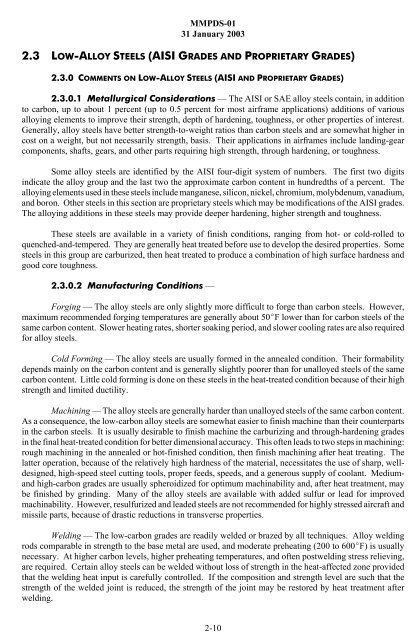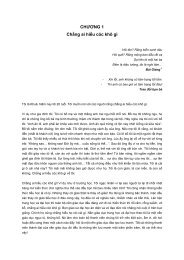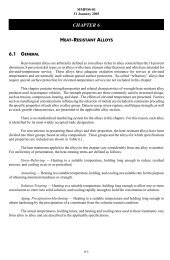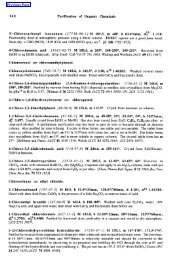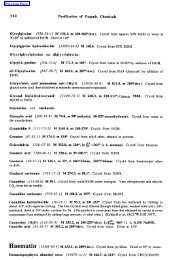steel - Nouvelle page 1 - Free
steel - Nouvelle page 1 - Free
steel - Nouvelle page 1 - Free
Create successful ePaper yourself
Turn your PDF publications into a flip-book with our unique Google optimized e-Paper software.
MMPDS-01<br />
31 January 2003<br />
2.3 LOW-ALLOY STEELS (AISI GRADES AND PROPRIETARY GRADES)<br />
2.3.0 COMMENTS ON LOW-ALLOY STEELS (AISI AND PROPRIETARY GRADES)<br />
2.3.0.1 Metallurgical Considerations — The AISI or SAE alloy <strong>steel</strong>s contain, in addition<br />
to carbon, up to about 1 percent (up to 0.5 percent for most airframe applications) additions of various<br />
alloying elements to improve their strength, depth of hardening, toughness, or other properties of interest.<br />
Generally, alloy <strong>steel</strong>s have better strength-to-weight ratios than carbon <strong>steel</strong>s and are somewhat higher in<br />
cost on a weight, but not necessarily strength, basis. Their applications in airframes include landing-gear<br />
components, shafts, gears, and other parts requiring high strength, through hardening, or toughness.<br />
Some alloy <strong>steel</strong>s are identified by the AISI four-digit system of numbers. The first two digits<br />
indicate the alloy group and the last two the approximate carbon content in hundredths of a percent. The<br />
alloying elements used in these <strong>steel</strong>s include manganese, silicon, nickel, chromium, molybdenum, vanadium,<br />
and boron. Other <strong>steel</strong>s in this section are proprietary <strong>steel</strong>s which may be modifications of the AISI grades.<br />
The alloying additions in these <strong>steel</strong>s may provide deeper hardening, higher strength and toughness.<br />
These <strong>steel</strong>s are available in a variety of finish conditions, ranging from hot- or cold-rolled to<br />
quenched-and-tempered. They are generally heat treated before use to develop the desired properties. Some<br />
<strong>steel</strong>s in this group are carburized, then heat treated to produce a combination of high surface hardness and<br />
good core toughness.<br />
2.3.0.2 Manufacturing Conditions —<br />
Forging — The alloy <strong>steel</strong>s are only slightly more difficult to forge than carbon <strong>steel</strong>s. However,<br />
maximum recommended forging temperatures are generally about 50EF lower than for carbon <strong>steel</strong>s of the<br />
same carbon content. Slower heating rates, shorter soaking period, and slower cooling rates are also required<br />
for alloy <strong>steel</strong>s.<br />
Cold Forming — The alloy <strong>steel</strong>s are usually formed in the annealed condition. Their formability<br />
depends mainly on the carbon content and is generally slightly poorer than for unalloyed <strong>steel</strong>s of the same<br />
carbon content. Little cold forming is done on these <strong>steel</strong>s in the heat-treated condition because of their high<br />
strength and limited ductility.<br />
Machining — The alloy <strong>steel</strong>s are generally harder than unalloyed <strong>steel</strong>s of the same carbon content.<br />
As a consequence, the low-carbon alloy <strong>steel</strong>s are somewhat easier to finish machine than their counterparts<br />
in the carbon <strong>steel</strong>s. It is usually desirable to finish machine the carburizing and through-hardening grades<br />
in the final heat-treated condition for better dimensional accuracy. This often leads to two steps in machining:<br />
rough machining in the annealed or hot-finished condition, then finish machining after heat treating. The<br />
latter operation, because of the relatively high hardness of the material, necessitates the use of sharp, welldesigned,<br />
high-speed <strong>steel</strong> cutting tools, proper feeds, speeds, and a generous supply of coolant. Mediumand<br />
high-carbon grades are usually spheroidized for optimum machinability and, after heat treatment, may<br />
be finished by grinding. Many of the alloy <strong>steel</strong>s are available with added sulfur or lead for improved<br />
machinability. However, resulfurized and leaded <strong>steel</strong>s are not recommended for highly stressed aircraft and<br />
missile parts, because of drastic reductions in transverse properties.<br />
Welding — The low-carbon grades are readily welded or brazed by all techniques. Alloy welding<br />
rods comparable in strength to the base metal are used, and moderate preheating (200 to 600EF) is usually<br />
necessary. At higher carbon levels, higher preheating temperatures, and often postwelding stress relieving,<br />
are required. Certain alloy <strong>steel</strong>s can be welded without loss of strength in the heat-affected zone provided<br />
that the welding heat input is carefully controlled. If the composition and strength level are such that the<br />
strength of the welded joint is reduced, the strength of the joint may be restored by heat treatment after<br />
welding.<br />
2-10


